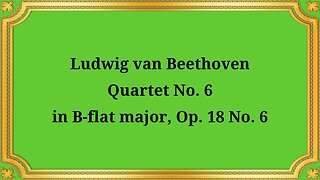Premium Only Content

Sergei Rachmaninoff Prelude №14 E Major Op 32, №3 (1951)
#SergeiRachmaninoff #classicalmusic #musicalcomposition #PreludeNo14EMajor #Op32No3 #piano #Russiancomposer #Romanticera #virtuosity #emotionaldepth #musicalinterpretation #musicappreciation #musictheory #classicalpiano #musicalgenius #musicperformance #musiccomposition
Publication date 1951
Dame Moura Lympany
Sergei Rachmaninoff, a visionary Russian composer of the Romantic era, left an indelible mark on the world of classical music through his rich and emotive compositions. Among his vast repertoire, Prelude No. 14 in E Major, Op 32, No. 3 shines as an exquisite gem, showcasing his exceptional talent and ability to evoke profound emotions through music.
Prelude No. 14 in E Major, Op 32, No. 3 is a solo piano composition that exemplifies Rachmaninoff's signature style. Composed in 1910, it is part of a larger collection of Preludes, each with its own unique character and musical language. This particular prelude stands out for its lyrical melodies, lush harmonies, and the emotional depth that Rachmaninoff effortlessly weaves into the fabric of the music.
At the heart of Prelude No. 14 lies a captivating melodic tapestry that unfolds with grace and sensitivity. Rachmaninoff's gift for crafting memorable melodies is showcased in this composition. The piece opens with a tender and introspective melody that gradually builds in intensity, leading the listener on an emotional journey. The melodic lines are imbued with expressive nuances, ranging from moments of tranquility and introspection to bursts of passionate fervor.
Rachmaninoff's Prelude No. 14 showcases his mastery of harmonic language and his ability to create rich, evocative textures. The piece features lush and intricate harmonies that add depth and complexity to the musical narrative. Rachmaninoff's use of chromaticism and unexpected chord progressions creates a sense of tension and release, heightening the emotional impact of the composition. The harmonic language of this prelude contributes to its enduring allure among musicians and audiences alike.
The performance and interpretation of Prelude No. 14 require a delicate balance between technical precision and expressive freedom. Pianists must navigate the virtuosic demands of the composition while embracing the emotional nuances embedded within the music. The interpretation of this prelude allows performers to infuse their own artistic sensibilities, resulting in a unique and personal rendering of Rachmaninoff's masterpiece.
Prelude No. 14 has solidified Rachmaninoff's place as one of the foremost composers of his time. Its melodic beauty, harmonic complexity, and emotional depth have made it a staple in the repertoire of pianists worldwide. The prelude's enduring popularity is a testament to Rachmaninoff's ability to connect with audiences on a profound level, transcending time and cultural boundaries.
Sergei Rachmaninoff's Prelude No. 14 E Major, Op 32, No. 3 is a musical work that continues to captivate listeners with its melodic richness, harmonic complexity, and emotional depth. Through its expressive nuances and virtuosic demands, this composition showcases Rachmaninoff's genius as a composer and his ability to evoke profound emotions in his audience. Prelude No. 14 stands as a testament to Rachmaninoff's enduring legacy in the world of classical music and serves as a testament to the power of music to move and inspire.
You have the opportunity to support the channel:
https://destream.net/live/RadSiarAl/donate
https://www.buymeacoffee.com/6355radsiaral
-
 22:54
22:54
Classical music_Music Inspiration
8 days agoLudwig van Beethoven Quartet No. 6 in B-flat major, Op. 18 No. 6
272 -
 1:05:11
1:05:11
Donald Trump Jr.
3 hours agoBuilding the Future with American Bitcoin, Plus Eric's Triggered Debut! | TRIGGERED Ep.272
94.2K52 -
 LIVE
LIVE
MissesMaam
6 hours agoLetting a Game from 2009 RageBait Me | Achievement Hunting PVZ 💚✨
35 watching -
 1:01:40
1:01:40
The Nick DiPaolo Show Channel
5 hours agoTrump Waiting On Tariff Ruling | The Nick Di Paolo Show #1788
22.7K20 -
 LIVE
LIVE
jordobombay
2 hours agoWarzone Update, Massive Day For The Unemployed
18 watching -
 LIVE
LIVE
EzekielMaxwellVT
1 hour agoVTuber/VRumbler -Elden Ring Nightreign - WALKING MOUTH AND CRACKED OUT DOGGY
41 watching -
 1:23:59
1:23:59
Dr. Drew
9 hours agoSalty Cracker: Dr. Drew's Birthday, Sydney Sweeney's Jeans, Rosie's Apology To MAGA & More News From Our Clown World – Ask Dr. Drew
94.1K50 -
 1:04:40
1:04:40
BonginoReport
3 hours agoMAHA Madness: RFK Jr. vs Newsom - Nightly Scroll w/ Hayley Caronia (Ep.127) - 09/04/2025
51.5K24 -
 1:58:36
1:58:36
Redacted News
4 hours agoUkraine bans Christians, Trump Sends Troops to Chicago, German AFD members being murdered | Redacted
112K101 -
 1:17:43
1:17:43
Michael Franzese
3 hours agoMy Daughters CONFRONTED Me About Being a Mobster Dad
28.2K2